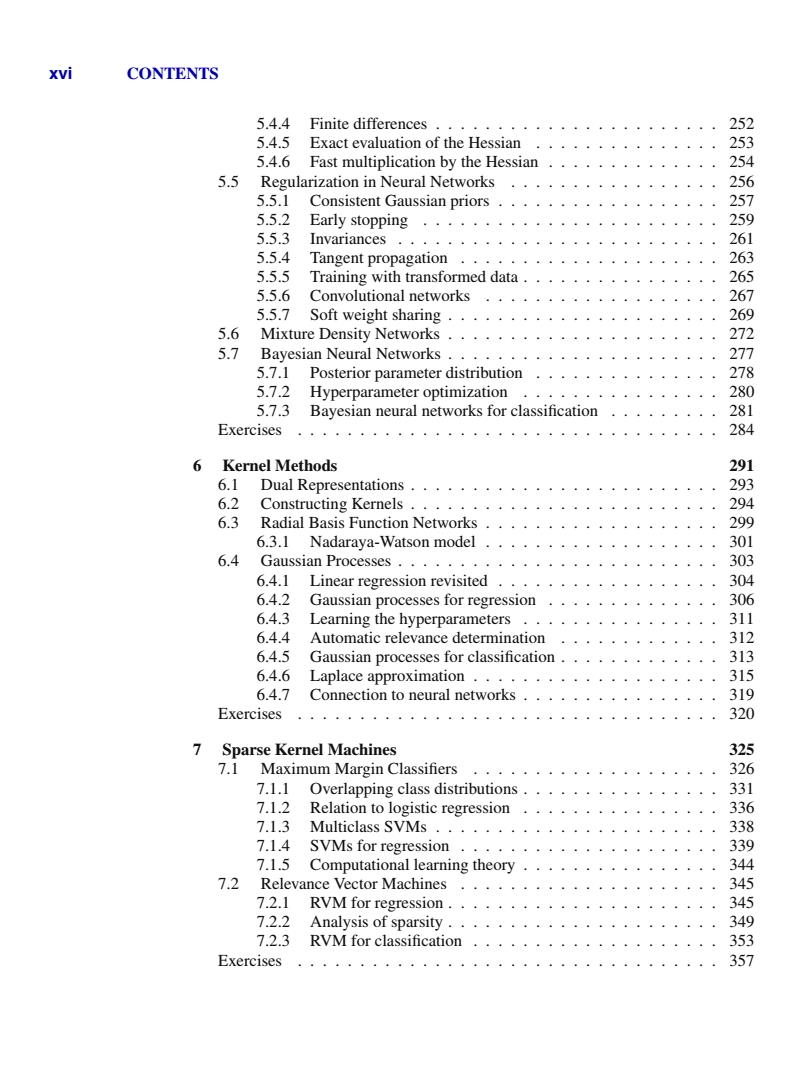
xvi CONTENTS 5.4.4 Finite differences....··· 252 5.4.5 Exact evaluation of the Hessian 253 5.4.6 Fast multiplication by the Hessian 254 5.5 Regularization in Neural Networks 256 5.5.1 Consistent Gaussian priors... 257 5.5.2 Early stopping 259 5.5.3 Invariances.. 261 5.5.4 Tangent propagation.··.·· 263 5.5.5 Training with transformed data..,······ 265 5.5.6 Convolutional networks 267 5.5.7 Soft weight sharing 269 5.6 Mixture Density Networks 272 5.7 Bayesian Neural Networks .. 277 5.7.1 Posterior parameter distribution 278 5.7.2 Hyperparameter optimization 280 5.7.3 Bayesian neural networks for classification 281 Exercises 284 6 Kernel Methods 291 6.1 Dual Representations,···· 293 6.2 Constructing Kernels...... 294 6.3 Radial Basis Function Networks 299 6.3.1 Nadaraya-Watson model.... 301 6.4 Gaussian Processes........... 303 6.4.1 Linear regression revisited 304 6.4.2 Gaussian processes for regression 306 6.4.3 Learning the hyperparameters 311 6.4.4 Automatic relevance determination 312 6.4.5 Gaussian processes for classification....... 313 6.4.6 Laplace approximation...,......·。. 315 6.4.7 Connection to neural networks..··..· 319 Exercises 320 7 Sparse Kernel Machines 325 7.1 Maximum Margin Classifiers 326 7.1.1 Overlapping class distributions.. 331 7.1.2 Relation to logistic regression 44444 336 7.1.3 Multiclass SVMs........ 338 7.1.4 SVMs for regression ... 339 7.1.5 Computational learning theory...·....· 344 7.2 Relevance Vector Machines 345 7.2.1 RVM for regression.··. 345 7.2.2 Analysis of sparsity .. 349 7.2.3 RVM for classification 353 Exercises 357
xvi CONTENTS 5.4.4 Finite differences . . . . . . . . . . . . . . . . . . . . . . . 252 5.4.5 Exact evaluation of the Hessian . . . . . . . . . . . . . . . 253 5.4.6 Fast multiplication by the Hessian . . . . . . . . . . . . . . 254 5.5 Regularization in Neural Networks . . . . . . . . . . . . . . . . . 256 5.5.1 Consistent Gaussian priors . . . . . . . . . . . . . . . . . . 257 5.5.2 Early stopping . . . . . . . . . . . . . . . . . . . . . . . . 259 5.5.3 Invariances . . . . . . . . . . . . . . . . . . . . . . . . . . 261 5.5.4 Tangent propagation . . . . . . . . . . . . . . . . . . . . . 263 5.5.5 Training with transformed data . . . . . . . . . . . . . . . . 265 5.5.6 Convolutional networks . . . . . . . . . . . . . . . . . . . 267 5.5.7 Soft weight sharing . . . . . . . . . . . . . . . . . . . . . . 269 5.6 Mixture Density Networks . . . . . . . . . . . . . . . . . . . . . . 272 5.7 Bayesian Neural Networks . . . . . . . . . . . . . . . . . . . . . . 277 5.7.1 Posterior parameter distribution . . . . . . . . . . . . . . . 278 5.7.2 Hyperparameter optimization . . . . . . . . . . . . . . . . 280 5.7.3 Bayesian neural networks for classification . . . . . . . . . 281 Exercises . . . . . . . . . . . . . . . . . . . . . . . . . . . . . . . . . . 284 6 Kernel Methods 291 6.1 Dual Representations . . . . . . . . . . . . . . . . . . . . . . . . . 293 6.2 Constructing Kernels . . . . . . . . . . . . . . . . . . . . . . . . . 294 6.3 Radial Basis Function Networks . . . . . . . . . . . . . . . . . . . 299 6.3.1 Nadaraya-Watson model . . . . . . . . . . . . . . . . . . . 301 6.4 Gaussian Processes . . . . . . . . . . . . . . . . . . . . . . . . . . 303 6.4.1 Linear regression revisited . . . . . . . . . . . . . . . . . . 304 6.4.2 Gaussian processes for regression . . . . . . . . . . . . . . 306 6.4.3 Learning the hyperparameters . . . . . . . . . . . . . . . . 311 6.4.4 Automatic relevance determination . . . . . . . . . . . . . 312 6.4.5 Gaussian processes for classification . . . . . . . . . . . . . 313 6.4.6 Laplace approximation . . . . . . . . . . . . . . . . . . . . 315 6.4.7 Connection to neural networks . . . . . . . . . . . . . . . . 319 Exercises . . . . . . . . . . . . . . . . . . . . . . . . . . . . . . . . . . 320 7 Sparse Kernel Machines 325 7.1 Maximum Margin Classifiers . . . . . . . . . . . . . . . . . . . . 326 7.1.1 Overlapping class distributions . . . . . . . . . . . . . . . . 331 7.1.2 Relation to logistic regression . . . . . . . . . . . . . . . . 336 7.1.3 Multiclass SVMs . . . . . . . . . . . . . . . . . . . . . . . 338 7.1.4 SVMs for regression . . . . . . . . . . . . . . . . . . . . . 339 7.1.5 Computational learning theory . . . . . . . . . . . . . . . . 344 7.2 Relevance Vector Machines . . . . . . . . . . . . . . . . . . . . . 345 7.2.1 RVM for regression . . . . . . . . . . . . . . . . . . . . . . 345 7.2.2 Analysis of sparsity . . . . . . . . . . . . . . . . . . . . . . 349 7.2.3 RVM for classification . . . . . . . . . . . . . . . . . . . . 353 Exercises . . . . . . . . . . . . . . . . . . . . . . . . . . . . . . . . . . 357
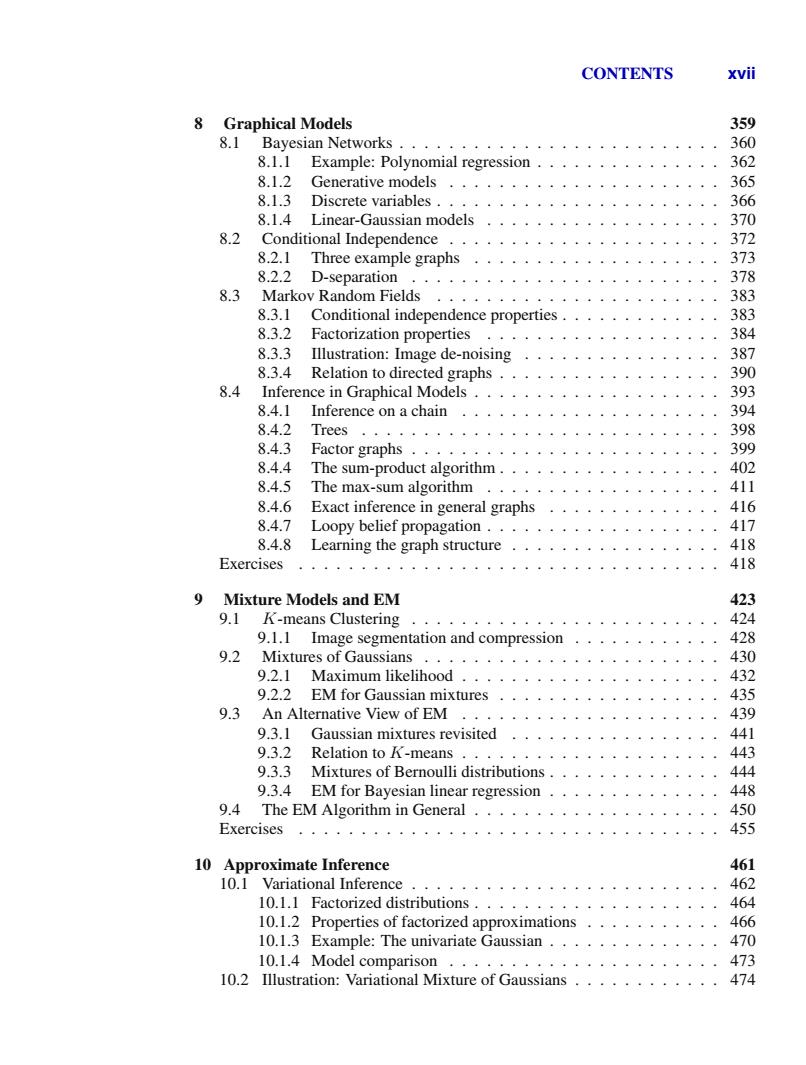
CONTENTS xvii 8 Graphical Models 359 8.1 Bayesian Networks.··.·.··················· 360 8.1.1 Example:Polynomial regression............... 362 8.1.2 Generative models 365 8.1.3 Discrete variables................ 366 8.1.4 Linear-Gaussian models 370 8.2 Conditional Independence.. 372 8.2.1 Three example graphs.·...·..·····- 373 8.2.2D-separation··········· 4 378 8.3 Markov Random Fields....... 383 8.3.1 Conditional independence properties........ 383 8.3.2 Factorization properties··.·········· 384 8.3.3 Illustration:Image de-noising 387 8.3.4 Relation to directed graphs..... 390 8.4 Inference in Graphical Models.... 393 8.4.1 Inference on a chain.... 394 8.4.2 Trees········· 398 8.4.3 Factor graphs.···.···· 404。 399 8.4.4 The sum-product algorithm.. 402 8.4.5 The max-sum algorithm ... 411 8.4.6 Exact inference in general graphs 416 8.4.7 Loopy belief propagation.·· 417 8.4.8 Learning the graph structure 418 Exercises 418 9 Mixture Models and EM 423 9.1 K-means Clustering 424 9.l.1 Image segmentation and compression······ 428 9.2 Mixtures of Gaussians........··.··.···. 430 9.2.1 Maximum likelihood........··.·.··. 432 9.2.2 EM for Gaussian mixtures. 435 9.3 An Alternative View of EM ... 439 9.3.1 Gaussian mixtures revisited 441 9.3.2 Relation to K'-means.... 443 9.3.3 Mixtures of Bernoulli distributions. 444 9.3.4 EM for Bayesian linear regression·············· 448 9.4 The EM Algorithm in General................ 450 Exercises································ 455 10 Approximate Inference 461 l0.1 Variational Inference......·.················· 462 10.1.1 Factorized distributions...... 464 l0.l.2 Properties of factorized approximations·.....··. 466 l0.l.3 Example:The univariate Gaussian.············· 470 10.1.4 Model comparison...... 473 10.2 Illustration:Variational Mixture of Gaussians........ 474
CONTENTS xvii 8 Graphical Models 359 8.1 Bayesian Networks . . . . . . . . . . . . . . . . . . . . . . . . . . 360 8.1.1 Example: Polynomial regression . . . . . . . . . . . . . . . 362 8.1.2 Generative models . . . . . . . . . . . . . . . . . . . . . . 365 8.1.3 Discrete variables . . . . . . . . . . . . . . . . . . . . . . . 366 8.1.4 Linear-Gaussian models . . . . . . . . . . . . . . . . . . . 370 8.2 Conditional Independence . . . . . . . . . . . . . . . . . . . . . . 372 8.2.1 Three example graphs . . . . . . . . . . . . . . . . . . . . 373 8.2.2 D-separation . . . . . . . . . . . . . . . . . . . . . . . . . 378 8.3 Markov Random Fields . . . . . . . . . . . . . . . . . . . . . . . 383 8.3.1 Conditional independence properties . . . . . . . . . . . . . 383 8.3.2 Factorization properties . . . . . . . . . . . . . . . . . . . 384 8.3.3 Illustration: Image de-noising . . . . . . . . . . . . . . . . 387 8.3.4 Relation to directed graphs . . . . . . . . . . . . . . . . . . 390 8.4 Inference in Graphical Models . . . . . . . . . . . . . . . . . . . . 393 8.4.1 Inference on a chain . . . . . . . . . . . . . . . . . . . . . 394 8.4.2 Trees . . . . . . . . . . . . . . . . . . . . . . . . . . . . . 398 8.4.3 Factor graphs . . . . . . . . . . . . . . . . . . . . . . . . . 399 8.4.4 The sum-product algorithm . . . . . . . . . . . . . . . . . . 402 8.4.5 The max-sum algorithm . . . . . . . . . . . . . . . . . . . 411 8.4.6 Exact inference in general graphs . . . . . . . . . . . . . . 416 8.4.7 Loopy belief propagation . . . . . . . . . . . . . . . . . . . 417 8.4.8 Learning the graph structure . . . . . . . . . . . . . . . . . 418 Exercises . . . . . . . . . . . . . . . . . . . . . . . . . . . . . . . . . . 418 9 Mixture Models and EM 423 9.1 K-means Clustering . . . . . . . . . . . . . . . . . . . . . . . . . 424 9.1.1 Image segmentation and compression . . . . . . . . . . . . 428 9.2 Mixtures of Gaussians . . . . . . . . . . . . . . . . . . . . . . . . 430 9.2.1 Maximum likelihood . . . . . . . . . . . . . . . . . . . . . 432 9.2.2 EM for Gaussian mixtures . . . . . . . . . . . . . . . . . . 435 9.3 An Alternative View of EM . . . . . . . . . . . . . . . . . . . . . 439 9.3.1 Gaussian mixtures revisited . . . . . . . . . . . . . . . . . 441 9.3.2 Relation to K-means . . . . . . . . . . . . . . . . . . . . . 443 9.3.3 Mixtures of Bernoulli distributions . . . . . . . . . . . . . . 444 9.3.4 EM for Bayesian linear regression . . . . . . . . . . . . . . 448 9.4 The EM Algorithm in General . . . . . . . . . . . . . . . . . . . . 450 Exercises . . . . . . . . . . . . . . . . . . . . . . . . . . . . . . . . . . 455 10 Approximate Inference 461 10.1 Variational Inference . . . . . . . . . . . . . . . . . . . . . . . . . 462 10.1.1 Factorized distributions . . . . . . . . . . . . . . . . . . . . 464 10.1.2 Properties of factorized approximations . . . . . . . . . . . 466 10.1.3 Example: The univariate Gaussian . . . . . . . . . . . . . . 470 10.1.4 Model comparison . . . . . . . . . . . . . . . . . . . . . . 473 10.2 Illustration: Variational Mixture of Gaussians . . . . . . . . . . . . 474
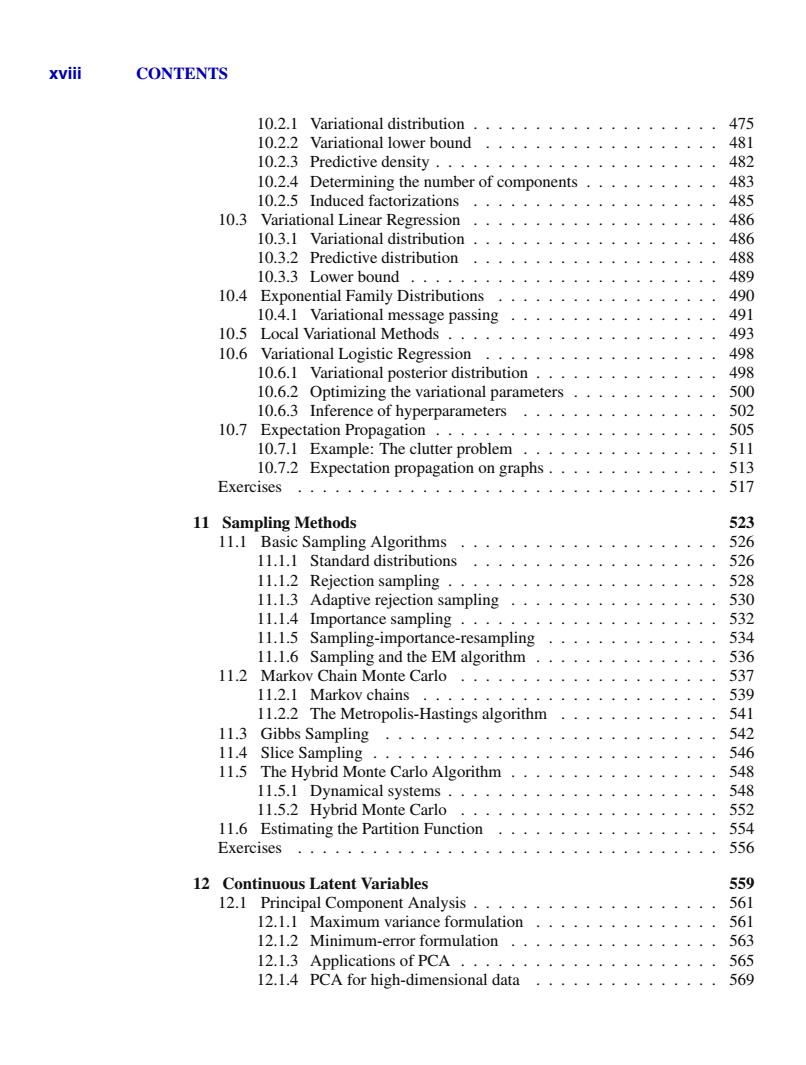
xviii CONTENTS l0.2.1 Variational distribution...,。....··.········ 475 10.2.2 Variational lower bound 481 l0.2.3 Predictive density....................··· 482 10.2.4 Determining the number of components 483 10.2.5 Induced factorizations 485 10.3 Variational Linear Regression 486 10.3.1 Variational distribution 486 10.3.2 Predictive distribution 488 10.3.3 Lower bound...... 489 10.4 Exponential Family Distributions 490 10.4.1 Variational message passing 。 ”44 491 l0.5 Local Variational Methods.·.·... 493 10.6 Variational Logistic Regression . 498 10.6.1 Variational posterior distribution 498 10.6.2 Optimizing the variational parameters....... 500 10.6.3 Inference of hyperparameters 502 10.7 Expectation Propagation········ 505 10.7.1 Example:The clutter problem 511 l0.7.2 Expectation propagation on graphs.······· 513 Exercises..················· 517 11 Sampling Methods 523 ll.1 Basic Sampling Algorithms·····. 526 11.1.1 Standard distributions 526 ll.l.2 Rejection sampling.···· 528 11.1.3 Adaptive rejection sampling 530 11.1.4 Importance sampling 532 11.1.5 Sampling-importance-resampling 534 11.1.6 Sampling and the EM algorithm. 536 11.2 Markov Chain Monte Carlo ...... 537 11.2.1 Markov chains..... 539 11.2.2 The Metropolis-Hastings algorithm 541 11.3 Gibbs Sampling 542 11.4 Slice Sampling.......... 546 ll.5 The Hybrid Monte Carlo Algorithm...··.···· 548 1l.5.1 Dynamical systems.··············· 548 11.5.2 Hybrid Monte Carlo............... 552 11.6 Estimating the Partition Function 554 Exercises.····。··········· 556 12 Continuous Latent Variables 559 l2.1 Principal Component Analysis.··· 561 12.1.1 Maximum variance formulation.. 561 l2.l.2 Minimum-error formulation...········ 563 12.1.3 Applications of PCA...... 565 l2.l.4 PCA for high-dimensional data..·..·.·. 569
xviii CONTENTS 10.2.1 Variational distribution . . . . . . . . . . . . . . . . . . . . 475 10.2.2 Variational lower bound . . . . . . . . . . . . . . . . . . . 481 10.2.3 Predictive density . . . . . . . . . . . . . . . . . . . . . . . 482 10.2.4 Determining the number of components . . . . . . . . . . . 483 10.2.5 Induced factorizations . . . . . . . . . . . . . . . . . . . . 485 10.3 Variational Linear Regression . . . . . . . . . . . . . . . . . . . . 486 10.3.1 Variational distribution . . . . . . . . . . . . . . . . . . . . 486 10.3.2 Predictive distribution . . . . . . . . . . . . . . . . . . . . 488 10.3.3 Lower bound . . . . . . . . . . . . . . . . . . . . . . . . . 489 10.4 Exponential Family Distributions . . . . . . . . . . . . . . . . . . 490 10.4.1 Variational message passing . . . . . . . . . . . . . . . . . 491 10.5 Local Variational Methods . . . . . . . . . . . . . . . . . . . . . . 493 10.6 Variational Logistic Regression . . . . . . . . . . . . . . . . . . . 498 10.6.1 Variational posterior distribution . . . . . . . . . . . . . . . 498 10.6.2 Optimizing the variational parameters . . . . . . . . . . . . 500 10.6.3 Inference of hyperparameters . . . . . . . . . . . . . . . . 502 10.7 Expectation Propagation . . . . . . . . . . . . . . . . . . . . . . . 505 10.7.1 Example: The clutter problem . . . . . . . . . . . . . . . . 511 10.7.2 Expectation propagation on graphs . . . . . . . . . . . . . . 513 Exercises . . . . . . . . . . . . . . . . . . . . . . . . . . . . . . . . . . 517 11 Sampling Methods 523 11.1 Basic Sampling Algorithms . . . . . . . . . . . . . . . . . . . . . 526 11.1.1 Standard distributions . . . . . . . . . . . . . . . . . . . . 526 11.1.2 Rejection sampling . . . . . . . . . . . . . . . . . . . . . . 528 11.1.3 Adaptive rejection sampling . . . . . . . . . . . . . . . . . 530 11.1.4 Importance sampling . . . . . . . . . . . . . . . . . . . . . 532 11.1.5 Sampling-importance-resampling . . . . . . . . . . . . . . 534 11.1.6 Sampling and the EM algorithm . . . . . . . . . . . . . . . 536 11.2 Markov Chain Monte Carlo . . . . . . . . . . . . . . . . . . . . . 537 11.2.1 Markov chains . . . . . . . . . . . . . . . . . . . . . . . . 539 11.2.2 The Metropolis-Hastings algorithm . . . . . . . . . . . . . 541 11.3 Gibbs Sampling . . . . . . . . . . . . . . . . . . . . . . . . . . . 542 11.4 Slice Sampling . . . . . . . . . . . . . . . . . . . . . . . . . . . . 546 11.5 The Hybrid Monte Carlo Algorithm . . . . . . . . . . . . . . . . . 548 11.5.1 Dynamical systems . . . . . . . . . . . . . . . . . . . . . . 548 11.5.2 Hybrid Monte Carlo . . . . . . . . . . . . . . . . . . . . . 552 11.6 Estimating the Partition Function . . . . . . . . . . . . . . . . . . 554 Exercises . . . . . . . . . . . . . . . . . . . . . . . . . . . . . . . . . . 556 12 Continuous Latent Variables 559 12.1 Principal Component Analysis . . . . . . . . . . . . . . . . . . . . 561 12.1.1 Maximum variance formulation . . . . . . . . . . . . . . . 561 12.1.2 Minimum-error formulation . . . . . . . . . . . . . . . . . 563 12.1.3 Applications of PCA . . . . . . . . . . . . . . . . . . . . . 565 12.1.4 PCA for high-dimensional data . . . . . . . . . . . . . . . 569
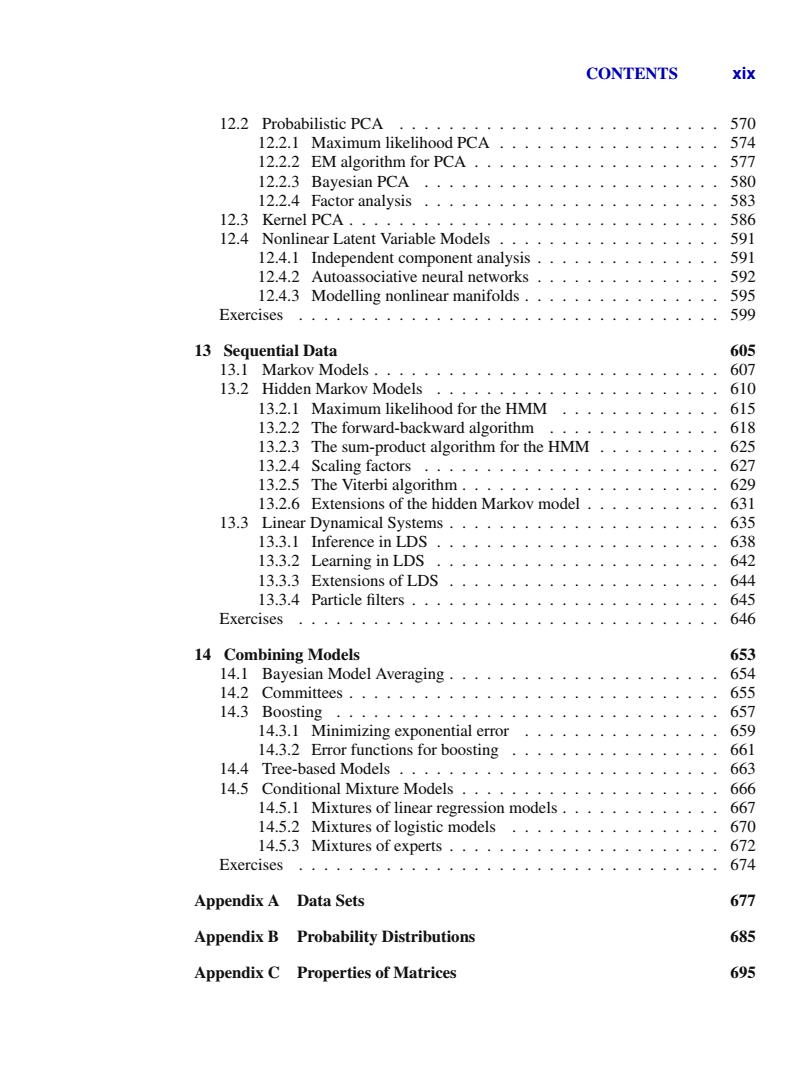
CONTENTS xix 12.2 Probabilistic PCA 570 12.2.1 Maximum likelihood PCA...·.···· 574 12.2.2 EM algorithm for PCA............ 577 12.2.3 Bayesian PCA 580 12.2.4 Factor analysis 583 12.3 Kernel PCA......... 586 12.4 Nonlinear Latent Variable Models 591 12.4.1 Independent component analysis 591 12.4.2 Autoassociative neural networks 592 12.4.3 Modelling nonlinear manifolds. 595 Exercises...·....·····.······ 4 599 13 Sequential Data 605 13.1 Markov Models......... 607 13.2 Hidden Markov Models... 610 13.2.1 Maximum likelihood for the HMM 615 13.2.2 The forward-backward algorithm 618 13.2.3 The sum-product algorithm for the HMM 625 l3.2.4 Scaling factors.....·...·.. 627 13.2.5 The Viterbi algorithm......... 629 13.2.6 Extensions of the hidden Markov model 631 13.3 Linear Dynamical Systems.. 4 635 13.3.1 Inference in LDS 638 13.3.2 Learning in LDS 642 13.3.3 Extensions of LDS 644 13.3.4 Particle filters .. 。44444.4 645 Exercises.......... 646 14 Combining Models 653 14.1 Bayesian Model Averaging... 654 14.2 Committees...··········- 655 14.3 Boosting 657 14.3.1 Minimizing exponential error 659 14.3.2 Error functions for boosting 661 14.4 Tree-based Models........... 663 14.5 Conditional Mixture Models... 666 14.5.1 Mixtures of linear regression models....... 667 14.5.2 Mixtures of logistic models 670 l4.5.3 Mixtures of experts.·,············· 672 Exercises········ 4 674 Appendix A】 Data Sets 677 Appendix B Probability Distributions 685 Appendix C Properties of Matrices 695
CONTENTS xix 12.2 Probabilistic PCA . . . . . . . . . . . . . . . . . . . . . . . . . . 570 12.2.1 Maximum likelihood PCA . . . . . . . . . . . . . . . . . . 574 12.2.2 EM algorithm for PCA . . . . . . . . . . . . . . . . . . . . 577 12.2.3 Bayesian PCA . . . . . . . . . . . . . . . . . . . . . . . . 580 12.2.4 Factor analysis . . . . . . . . . . . . . . . . . . . . . . . . 583 12.3 Kernel PCA . . . . . . . . . . . . . . . . . . . . . . . . . . . . . . 586 12.4 Nonlinear Latent Variable Models . . . . . . . . . . . . . . . . . . 591 12.4.1 Independent component analysis . . . . . . . . . . . . . . . 591 12.4.2 Autoassociative neural networks . . . . . . . . . . . . . . . 592 12.4.3 Modelling nonlinear manifolds . . . . . . . . . . . . . . . . 595 Exercises . . . . . . . . . . . . . . . . . . . . . . . . . . . . . . . . . . 599 13 Sequential Data 605 13.1 Markov Models . . . . . . . . . . . . . . . . . . . . . . . . . . . . 607 13.2 Hidden Markov Models . . . . . . . . . . . . . . . . . . . . . . . 610 13.2.1 Maximum likelihood for the HMM . . . . . . . . . . . . . 615 13.2.2 The forward-backward algorithm . . . . . . . . . . . . . . 618 13.2.3 The sum-product algorithm for the HMM . . . . . . . . . . 625 13.2.4 Scaling factors . . . . . . . . . . . . . . . . . . . . . . . . 627 13.2.5 The Viterbi algorithm . . . . . . . . . . . . . . . . . . . . . 629 13.2.6 Extensions of the hidden Markov model . . . . . . . . . . . 631 13.3 Linear Dynamical Systems . . . . . . . . . . . . . . . . . . . . . . 635 13.3.1 Inference in LDS . . . . . . . . . . . . . . . . . . . . . . . 638 13.3.2 Learning in LDS . . . . . . . . . . . . . . . . . . . . . . . 642 13.3.3 Extensions of LDS . . . . . . . . . . . . . . . . . . . . . . 644 13.3.4 Particle filters . . . . . . . . . . . . . . . . . . . . . . . . . 645 Exercises . . . . . . . . . . . . . . . . . . . . . . . . . . . . . . . . . . 646 14 Combining Models 653 14.1 Bayesian Model Averaging . . . . . . . . . . . . . . . . . . . . . . 654 14.2 Committees . . . . . . . . . . . . . . . . . . . . . . . . . . . . . . 655 14.3 Boosting . . . . . . . . . . . . . . . . . . . . . . . . . . . . . . . 657 14.3.1 Minimizing exponential error . . . . . . . . . . . . . . . . 659 14.3.2 Error functions for boosting . . . . . . . . . . . . . . . . . 661 14.4 Tree-based Models . . . . . . . . . . . . . . . . . . . . . . . . . . 663 14.5 Conditional Mixture Models . . . . . . . . . . . . . . . . . . . . . 666 14.5.1 Mixtures of linear regression models . . . . . . . . . . . . . 667 14.5.2 Mixtures of logistic models . . . . . . . . . . . . . . . . . 670 14.5.3 Mixtures of experts . . . . . . . . . . . . . . . . . . . . . . 672 Exercises . . . . . . . . . . . . . . . . . . . . . . . . . . . . . . . . . . 674 Appendix A Data Sets 677 Appendix B Probability Distributions 685 Appendix C Properties of Matrices 695
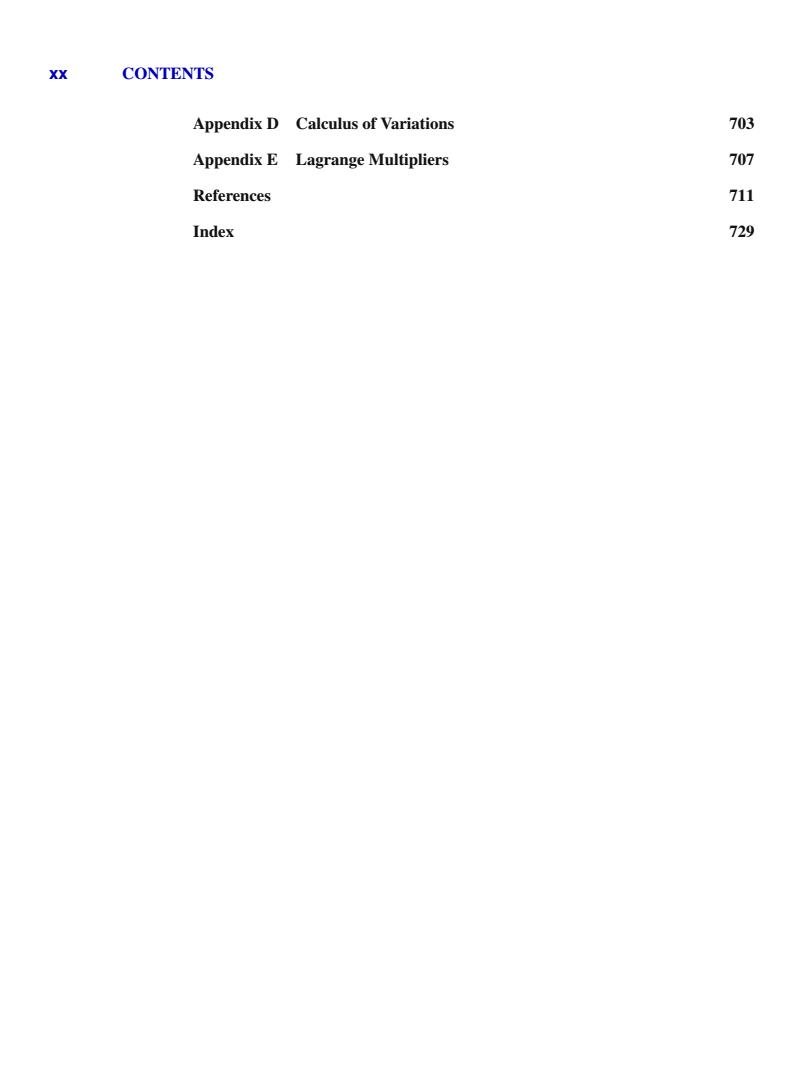
XX CONTENTS Appendix D Calculus of Variations 703 Appendix E Lagrange Multipliers 707 References 711 Index 729
xx CONTENTS Appendix D Calculus of Variations 703 Appendix E Lagrange Multipliers 707 References 711 Index 729